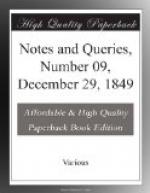So much for the introduction to the following Queries:—1. Can any of your readers say whether this amulet is still in possession of the President of the French Republic? 2. If so, might not the believers in the doctrines of Sympathy attribute the votes of the six millions who, in Dec. 1848, voted in favour of his election, to the sympathetic influence of his “nut in gold filigree,” and be justified in looking upon those who voted for his rivals as no true Franks? It was originally concocted for a Frankish monarch of pure blood, and may be supposed to exercise its potency only on those of genuine descent and untainted lineage.
WILLIAM BELL, Phil. Dr.
* * * * *
DICK SHORE—ISLE OF DOGS—KATHERINE PEGG.
I entirely concur in the opinion of your able correspondent, Mr. P. Cunningham, that Pepys’s Diary is well deserving all the illustrative light which may be reflected upon it from your useful pages. In submitting the following Query, however, my object is to glean a scrap of information on a point connected with the neglected topography of the east end of London, taking Pepys for my text. In the Diary, the entry for January 15th, 1660-61, contains this passage:—
“We took barge and went to Blackwall, and viewed the Dock and the new west Dock which is newly made there, and a brave new merchantman which is to launched shortly, and they say to be called the Royal Oake. Hence we walked to Dick Shoare, and thence to the Towre, and so home.”—Vol. i. p. 178. new Ed.
I shall be glad to learn from any of your readers what part of the northern bank of the river, between Blackwall and the Tower, was called Dick Shore. It is not marked on any of the old maps of London I have been able to consult; but it was probably beyond the most easterly point generally shown within their limits. The modern maps present no trace of the locality in question.
The dock-yard visited by Pepys was long one of the most considerable private ship-building establishments in England. For may years it was conducted by Mr. Perry, and subsequently, under the firm of Wigram and Green, the property having been purchased by the late Sir Robert Wigram, Bart. The extensive premises are still applied to the same use; but they have been divided to form two distinct yards, conducted by separate firms.




